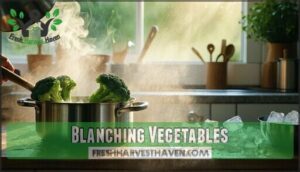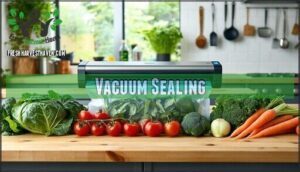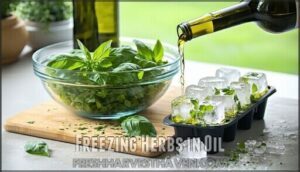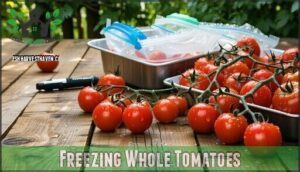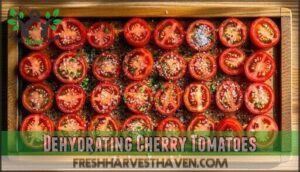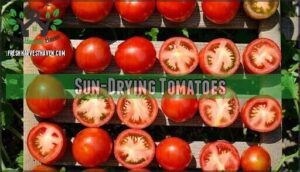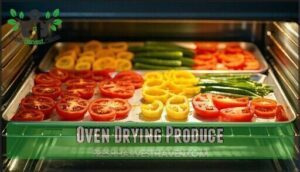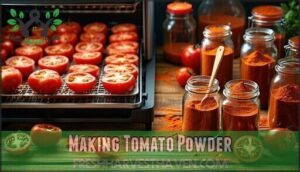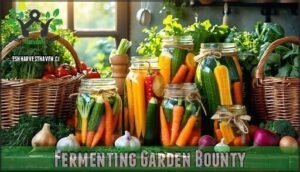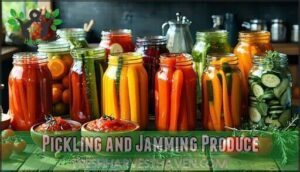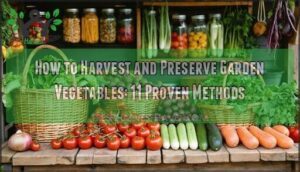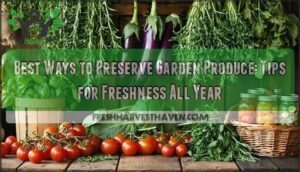This site is supported by our readers. We may earn a commission, at no cost to you, if you purchase through links.
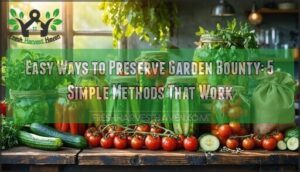 You’ve got five solid options for turning your garden overflow into pantry gold.
You’ve got five solid options for turning your garden overflow into pantry gold.
Canning works beautifully for tomatoes and high-acid foods, while freezing keeps flavors fresh with minimal fuss—just blanch those vegetables first.
Drying concentrates taste into concentrated gems, perfect for herbs and cherry tomatoes.
Fermenting adds gut-healthy probiotics to your harvest, creating tangy treasures like lacto-fermented salsa.
Pickling transforms excess produce into crisp, flavorful additions to winter meals.
The secret isn’t complicated equipment or years of experience—it’s matching the right preservation method to your specific produce and lifestyle.
These easy ways to preserve garden bounty become second nature once you understand which technique works best for each vegetable type, using methods like lacto-fermented salsa and preserving with minimal fuss to create tangy treasures and enjoy your harvest.
Table Of Contents
- Key Takeaways
- Canning Garden Produce
- Freezing Fresh Produce
- Drying Fruits and Vegetables
- Fermenting Garden Bounty
- Pickling and Jamming Produce
- Frequently Asked Questions (FAQs)
- How do you preserve a garden harvest?
- How can we preserve summer’s bounty all year long?
- What can you do with excess garden produce?
- How can food preservation help save the taste of summer?
- How do you store dried herbs?
- How do you preserve herbs?
- How to preserve your garden harvest?
- How to make garden vegetables last all year?
- What are the best ways to preserve?
- How do you preserve food without a garden?
- Conclusion
Key Takeaways
- You can match preservation methods to your specific produce—use water bath canning for high-acid foods like tomatoes, pressure canning for low-acid vegetables, and simple freezing for herbs and most fruits without complicated equipment.
- You’ll save time with minimal-prep techniques like freezing whole tomatoes (they don’t need blanching), making refrigerator pickles that skip traditional canning, and vacuum sealing portions for extended freshness.
- You can create probiotic-rich foods through lacto-fermentation by simply combining vegetables with salt water, turning excess cabbage into sauerkraut or cherry tomatoes into tangy flavor bombs that support digestive health.
- You’ll maximize your harvest’s shelf life by using complementary methods together—dry herbs in oil-filled ice cube trays for instant flavor, make concentrated tomato powder from dried slices, and combine roasting with canning for rich sauces that last months.
Canning Garden Produce
Canning transforms your garden’s abundance into shelf-stable foods that’ll last for months, using heat to destroy harmful microorganisms while sealing flavors inside glass jars.
Transform your garden’s overflow into pantry gold—canning locks in peak flavors while creating shelf-stable treasures that last for months.
You’ll need to choose between water bath canning for high-acid foods like tomatoes and pickles, or pressure canning for low-acid vegetables and meats, which is a critical step in the canning process.
Water Bath Canning
Water bath canning effectively preserves high-acid foods through proper jar sterilization and lid sealing techniques.
This food preservation method relies on maintaining correct acidity levels using safe recipes designed for home canners. Tested recipes are vital for safe canning.
- Sterilize jars in boiling water to prevent contamination
- Follow tested recipes that guarantee proper acidity levels
- Adjust processing times based on your altitude
- Submerge jars completely with one-inch water coverage above lids
Pressure Canning
While water bath canning works great for acidic foods, pressure canning is the only safe method for low-acid foods like green beans, corn, and meats.
This food preservation technique uses steam pressure to reach temperatures above 240°F, which destroys dangerous bacteria that cause botulism.
Your canner safety starts with annual gauge testing and proper venting. Always follow USDA processing times exactly—they’re calculated for your altitude and jar size.
Sealing jars properly requires new lids and correct headspace measurements.
This preserving method might seem intimidating, but it’s straightforward once you understand the basics. For instance, dial gauge canners require manual pressure monitoring.
Spoilage prevention depends on maintaining proper pressure throughout the process. With pressure canning, you’ll confidently preserve hearty vegetables and complete meals that’ll taste garden-fresh all winter long.
Canning Whole or Halved Tomatoes
While pressure canning handles low-acid foods perfectly, canning tomatoes requires a different approach.
Fresh tomatoes need extra attention since their natural acidity varies.
Here’s your straightforward tomato canning process:
- Add lemon juice – two tablespoons per quart jar boosts tomato acidity for safety
- Leave proper headspace – that half-inch gap prevents seal failures and spoilage
- Process in water bath – submerge sealed jars completely for recommended processing times
- Test seals after cooling – properly sealed lids won’t flex when pressed, ensuring storage safety
Canning High-Acid Foods
Water Bath Basics make canning high-acid foods simple and safe.
Fruits, jams, and jellies thrive with this gentle method since their natural Safe Acidity Levels prevent harmful bacteria.
Your Fruit Canning Guide starts with sterilized jars and proper headspace.
Pectin Usage helps jams set perfectly, while Jar Sealing Tips guarantee long-term storage success.
Follow tested Canning Recipes and processing times religiously.
Food Safety depends on checking seals after cooling completely.
Freezing Fresh Produce
Freezing offers the simplest way to preserve your garden harvest, requiring minimal preparation while maintaining nutrients and flavor for months.
You’ll find that most vegetables need blanching first to stop enzyme action, though fruits and peppers can go straight into freezer bags with proper labeling, which is a key step to ensure proper preservation.
Blanching Vegetables
Moving from canning to freezing opens up new possibilities for preserving your garden bounty.
Blanching vegetables before freezing acts like a protective shield, stopping enzymes that would otherwise rob your produce of flavor and nutrients.
Here’s your blanching roadmap for perfect vegetable preservation:
- Prep your vegetables by washing and cutting them into uniform pieces
- Boil water in a large pot and follow recommended blanching times for each vegetable type
- Plunge immediately into ice water for rapid cooling and enzyme inactivation
- Drain thoroughly to prevent ice crystals that damage texture preservation
- Package quickly while vegetables are still cold to maximize nutrient retention
This simple process locks in peak freshness for months of garden-fresh meals.
Vacuum Sealing
Beyond blanching, vacuum sealing transforms your food storage game. This preserving technique removes air from bags, preventing freezer burn and extending shelf-life dramatically.
You’ll find various vacuum sealer types, from handheld models to countertop units—each offering excellent cost effectiveness for garden preservation. Vacuum sealing inhibits mold and bacterial growth by removing oxygen.
Benefit What to Seal Why It Works
Extends freshness 5x longer
Prevents freezer burn
Saves money
Vacuum sealing makes food preservation simple and efficient while maximizing your garden’s bounty!
Freezing Herbs in Oil
Herb oil creates concentrated flavor bombs that’ll transform your cooking. This freezing technique preserves Oil Infusion Benefits while maintaining Herb Flavor Profiles year-round.
Freeze herb-infused oil cubes for instant flavor bursts that’ll make every dish sing with garden-fresh intensity.
- Chop fresh herbs like basil, parsley, or cilantro
- Mix with olive oil using a 2:1 herb-to-oil ratio
- Pour into ice cube trays for portion control
- Store frozen cubes in labeled bags for Storage Best Practices
These cubes add instant flavor to soups and sautés.
Freezing Whole Tomatoes
Regarding your overflowing garden bounty, freezing whole tomatoes couldn’t be simpler. Unlike other freezing vegetables that need blanching, tomatoes freeze beautifully without any prep work.
Here’s your straightforward approach:
- Wash and core fresh tomatoes completely
- Flash freeze on trays to prevent clumping together
- Transfer to freezer bags removing excess air for proper storage
- Label with dates for rotation and quality tracking
Skin removal happens naturally during thawing uses. Expect texture changes perfect for soups and sauces. Storage duration reaches twelve months with proper food preservation techniques.
Drying Fruits and Vegetables
Drying removes moisture from your produce to prevent spoilage, creating lightweight snacks and ingredients that store for months without refrigeration.
You can use a dehydrator, your oven, or even sunlight to transform fresh fruits and vegetables into concentrated flavors that work perfectly in soups, sauces, and trail mixes.
Dehydrating Cherry Tomatoes
Cherry tomatoes transform into concentrated flavor bombs through dehydrating food techniques.
Turn your cherry tomato overflow into intensely flavored gems that pack months of garden sunshine into every bite.
Cut your tomato variety in half, sprinkle with salt, and arrange on dehydrator trays. Set your dehydrator temperature to 135°F for chewy results or 150°F for crispy chips.
Drying time ranges from 6-9 hours depending on size. Consider using specialized drying racks for ideal results.
Add flavor enhancers like herbs before drying fruits. Store in airtight containers using proper storage methods for months of tangy goodness.
Sun-Drying Tomatoes
Sun-drying transforms garden tomatoes into flavor-packed gems through nature’s oldest preservation method. This sun-drying process works best with meaty varieties like Roma in hot, dry climates.
- Select ripe tomatoes: Choose firm, unblemished fruits
- Prep and slice: Blanch, halve, and remove seeds
- Arrange on racks: Single layer with good airflow
- Monitor daily: Turn pieces for even drying
- Store properly: Use airtight containers for best flavor enhancement.
Properly stored, they can last, offering extended pantry storage for up to six months.
Oven Drying Produce
Your kitchen oven transforms into a reliable dehydrator when you need to preserve garden produce.
Set the oven temperature to 140°F and arrange thinly sliced fruits or vegetables on baking sheets. Monitor drying time carefully since moisture content varies by produce selection.
This method works perfectly for drying herbs, fruits, and vegetables. Proper storage methods guarantee your dried harvest stays fresh for months.
Drying Temperatures Oven Placement Suitable Produce
Making Tomato Powder
Tomato powder transforms your garden’s overflow into a concentrated flavor powerhouse.
Simply slice fresh tomatoes thin, then dry them in your dehydrator at 135°F or use oven drying at the lowest setting until crisp. Grind the dried pieces into fine powder using a blender.
- DIY seasoning blends: Mix with herbs for custom spice combinations
- Storage solutions: Airtight containers keep powder fresh for months
- Nutritional benefits: Concentrated vitamins and minerals from garden tomatoes
Fermenting Garden Bounty
You can transform your excess vegetables into tangy, probiotic-rich foods through fermentation, a time-tested method that requires only salt, water, and patience.
This ancient preservation technique extends your harvest’s shelf life and also creates beneficial bacteria that support digestive health while developing complex, satisfying flavors, ultimately leading to probiotic-rich foods.
Lacto-Fermented Salsa
Lacto-fermented salsa transforms your garden harvest into a probiotic powerhouse that’s bursting with tangy flavor.
This ancient fermenting technique creates beneficial bacteria while preserving your tomatoes, peppers, and onions for months.
Fermentation Time: Allow 3-7 days at room temperature before refrigerating.
- Salsa Ingredients: Combine diced tomatoes, peppers, onions, garlic, and sea salt in clean mason jars
- Spicy Variations: Add jalapeños or habaneros for heat that mellows during lacto-fermentation
- Storage Tips: Keep vegetables submerged under brine using fermentation weights
Fermented Cherry Tomato Bombs
Cherry tomatoes transform into tangy flavor bombs through lactofermentation, creating probiotic-rich snacks that burst with umami goodness.
One key step involves adding the correct acidity to guarantee safe and successful fermentation.
Try fermenting cherry tomatoes—these tangy flavor bombs pack a probiotic punch while preserving your garden’s vibrant harvest.
| Brine Recipe | Fermentation Time | Storage Methods |
|---|---|---|
| 2% salt solution | 3-5 days countertop | Refrigerate after fermenting |
| Add garlic, herbs | Test daily for tang | Use within 2 months |
| Submerge completely | Cooler temps = slower | Keep below brine level |
| Weight down tomatoes | Warmer = faster process | Airtight containers work |
Flavor Development happens quickly. Culinary Uses include salads, pizza toppings, or straight snacking.
Sauerkraut and Kimchi
After experimenting with cherry tomato fermentation, you’ll find that lactofermentation works beautifully with cabbage varieties too.
Sauerkraut and kimchi showcase how different regional variations create distinct flavor profiles through simple fermenting techniques.
These probiotic-rich foods offer incredible health benefits while transforming humble cabbage into tangy treasures.
Here’s what makes these fermented favorites so appealing:
- Probiotic benefits support digestive health naturally
- Tangy flavors enhance any meal with zesty kicks
- Recipe ideas range from traditional to creative fusion
- Cabbage varieties offer different textures and tastes
- Regional variations provide endless culinary exploration opportunities
Fermenting Fruits and Vegetables
Transform your garden surplus into nutritious powerhouses through fermentation. This ancient technique creates probiotic benefits while delivering tangy flavors that elevate any meal.
- Start with fresh produce and proper brine recipes for fermentation safety.
- Master vegetable krauts using simple salt-water solutions.
- Experiment with fruit chutneys that develop complex flavors.
- Monitor the fermentation process for ideal results.
- Store finished probiotics in cool conditions.
Pickling and Jamming Produce
You’ll find pickling and jamming among the most rewarding ways to transform your garden’s excess into flavorful staples that last for months.
These methods require minimal equipment and time, turning everything from surplus cucumbers to overripe tomatoes into refrigerator pickles, homemade jams, and rich sauces that’ll enhance your meals year-round.
No-Work Refrigerator Pickles
Refrigerator pickles transform your garden bounty into tangy treats without traditional canning hassles.
Simply layer cucumber slices with dill and garlic in jars, then cover with hot brine made from equal parts vinegar and water plus salt. Quick pickling takes just hours, while pickle variations using chili flakes or mustard seeds add excitement.
To guarantee safety, remember that water bath canning is ideal for high-acid foods like pickles.
Proper storage tips guarantee maximum crispness factors.
Pickle Type Flavor Storage Effort
Making Jelly and Jam
Moving from crisp pickles to sweet preserves, jam making and jelly making transform fresh fruits into shelf-stable treasures.
You’ll need fruit, sugar, and pectin for proper gel formation.
High-pectin fruits like apples work naturally, while strawberries need commercial pectin sources.
Test jam consistency by dropping a spoonful on a cold plate—it should wrinkle when pushed.
- Flavor combinations like peach-basil or berry medleys create unique preserving fruits experiences
- Sugar alternatives including honey affect texture but add complexity
- Storage methods require proper canning techniques for long-term pantry success
Homemade jams beat store-bought every time.
Roasted Tomato Sauce
While jams capture sweetness, roasted tomato sauce delivers rich, concentrated flavor from your garden bounty. This technique transforms ordinary garden tomatoes into liquid gold without peeling hassles.
Roasting techniques caramelize natural sugars, creating depth that stovetop methods can’t match. Here’s your foolproof approach:
- Halve tomatoes and remove stems completely
- Arrange with onions in baking dishes, salt generously
- Drizzle olive oil and roast at 450°F for 45-50 minutes
- Blend to desired texture for perfect sauce consistency
Storage methods include freezing in glass jars or canning for shelf-stable recipe customization.
Homemade Ketchup Recipe
Building on your roasted tomato sauce success, homemade ketchup transforms your garden tomatoes into a beloved condiment. Start with Roma tomatoes, apple cider vinegar, brown sugar, and classic spices like onion powder and allspice. These ketchup ingredients create the perfect base for experimenting.
Your cooking methods matter – simmer slowly until thick, stirring frequently to prevent sticking. Flavor variations are endless: try smoked paprika for depth, maple syrup instead of sugar, or a pinch of cayenne for heat.
Unlike salsa recipes, ketchup requires longer cooking times. Proper canning techniques guarantee safe storage options for up to one year.
Your serving suggestions expand beyond burgers – this garden bounty enhances meatloaf, eggs, and roasted vegetables beautifully.
Frequently Asked Questions (FAQs)
How do you preserve a garden harvest?
Like squirrels gathering nuts for winter, you’ll want to can high-acid foods, freeze blanched vegetables, dry herbs and fruits, or ferment cabbage into tangy treasures that’ll keep your harvest alive.
How can we preserve summer’s bounty all year long?
You can preserve summer’s bounty using multiple methods: freeze blanched vegetables, can high-acid fruits, dry herbs and tomatoes, ferment cabbage into sauerkraut, and pickle cucumbers.
Each technique locks in nutrition and flavor year-round.
What can you do with excess garden produce?
You can share excess produce with neighbors, donate to food banks, preserve through canning or freezing, dehydrate for storage, create fermented foods, or host garden exchanges with fellow gardeners.
How can food preservation help save the taste of summer?
Summer’s sunshine gets captured like bottled memories when you freeze, can, or dry your harvest.
Each preserved bite brings back garden-fresh flavors during winter’s chill, letting you savor peak-season taste year-round.
How do you store dried herbs?
Store your dried herbs in airtight containers away from light and heat.
Mason jars work perfectly, or use small glass containers with tight-fitting lids.
Keep them in a cool, dark pantry for maximum potency.
How do you preserve herbs?
Dry them, freeze them, make them into oils—you’ve got options galore!
Vacuum seal fresh herbs, create herb-infused ice cubes, or whip up homemade pesto for year-round flavor that’ll make your taste buds dance.
How to preserve your garden harvest?
Freeze blanched vegetables in meal-sized portions, can high-acid fruits using water bath methods, dehydrate excess produce in a dehydrator, and ferment cabbage into sauerkraut for year-round nutrition.
How to make garden vegetables last all year?
Can, freeze, dry. Can your tomatoes and pickles using water bath methods. Freeze blanched vegetables in meal-sized portions. Dry herbs, peppers, and fruits with dehydrators. You’ll enjoy homegrown flavors year-round.
What are the best ways to preserve?
You’ve got several solid options for keeping your harvest fresh year-round.
Canning works great for tomatoes and pickles, while freezing handles most vegetables perfectly.
Dehydrating and fermenting add variety to your preservation toolkit, making canning a part of your overall strategy.
How do you preserve food without a garden?
You can preserve food by purchasing fresh produce from farmers markets, grocery stores, or pick-your-own farms, then applying the same canning, freezing, drying, and fermenting techniques used for homegrown harvests.
Conclusion
Like ancient civilizations who mastered preservation to survive harsh winters, you’ve now discovered five reliable methods to transform your garden’s abundance into year-round sustenance.
These easy ways to preserve garden bounty don’t require expensive equipment or decades of experience—just matching the right technique to your produce.
Whether you’re canning tomatoes, freezing herbs, or fermenting vegetables, you’ll create a well-stocked pantry that celebrates your harvest long after the growing season ends.
- https://www.preen.com/learn/lawn-garden-tips/plants-trees-shrubs/fruits-veggies-herbs/preserve-your-garden-bounty-by-freezing/
- https://www.offthegridnews.com/off-grid-foods/3-ways-to-preserve-your-gardens-bounty-for-months-and-even-years/
- https://www.columbian.com/news/2024/sep/07/preserve-your-gardens-bounty-the-easy-way/
- https://www.timberlinelandscaping.com/preserving-your-garden-bounty/
- https://www.urbanexodus.com/post/back-to-basics-preserve-the-harvest

